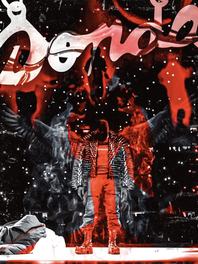CONCERT POSTER PART TWO
TWO ASSIGNMENTS: HOMEWORK AND PROJECT
1) HOMEWORK
Rough draft 50 points - Upload on Google Classroom
-
Must show at least 2 images that you will combine. If the band has a logo and you want to use it, that can count as an image.
Ex: The Red Hot Chili Peppers have a logo.
-
Example of a font
-
Information - Person, Date & Venue
-
Bay Area venues are listed below the requirements for this assignment.
-
-
FYI, your event can take place elsewhere.
-
Sketch of what you want the finished image to look like
PLAGIARISM
-
Automatic F for doing an exact replica of an existing image AKA, you must mix and match images
-
Automatic F for non-school-appropriate images like drugs, alcohol, weapons, ...etc.
-
Below are the images that were collected AND the rough draft that shows how you will combine all the info into a single image.
2) PAINTING PROJECT (INFORMATIVE POSTER)
The poster will be graded on the following
-
Paint - Clean lines, not thin or streaky coats
-
Strong Image / original logo that represents the band/artist
-
Font - should be centered in the chosen area, not bunched on one side. (Where will it go? What size(s) will you use?)
-
Top & bottom of the poster are the best places for this.
-
VENUE SIZES - A venue is a place for large gatherings. Venues come and go over time so you might want to make sure the venue you pick still exists.
Bar or club: These venues usually double as a nightclub that may or may not have well-known music acts play there. Most hold between 200 and 800 people. Bottom of the Hill, The Independent and 924 Gilman are all clubs.
Concert Hall or Ballroom: Generally refers to venues that are smaller than arenas and theaters. Most are exclusively general admission standing on the ground floor. Holds around 500 to 1,500. Examples include the Fillmore, Great American Music Hall, and the Regency Ballroom.
Theater: Many of them have both a general admission floor and reserved seating. A lot of them were built in the early 20th century to serve as movie theaters. Theaters hold a wide variety of people, but most hold between 1,000 to 4,000. Examples include the Fox Theater, the Warfield, and the Masonic.
Mini-arena: Larger than a theater but smaller than a full-sized arena. Mini-arenas usually have a single ring of seats that circle the building instead of the two or three you might see in an arena. There's also a general admission floor area next to the stage. Think of the Event Center at San Jose State University or Bill Graham Civic Auditorium. Most hold around 5,000 to 10,000 people.
Arena: These are where professional basketball and hockey teams play during half of the year. Most of the biggest named acts play here, such as Shawn Mendes, Pitbull, Pearl Jam, Swedish House Mafia and Twenty One Pilots. Reserved and floor seating are both available. Oracle Area, the SAP Center, and the Chase Center. Most arenas hold anywhere from 12,500 to 20,000 people for concerts.
Amphitheater: The largest outdoor acts play in amphitheaters when they don't want to play inside an arena. These venues are utilized more often in the summer. They range in size but many hold anywhere from 5,000 to 30,000 people. Think of the Greek Theatre, the Shoreline, Amphitheater and the Concord Pavillion.
Stadium: Only the biggest bands play here. Coldplay, the Weeknd, and Taylor Swift all play here. Stadiums can be either the baseball or the football variety, but most hold between 40,000 and 100,000 people. The Colosseum and Levi's Stadium are examples of this type of venue.


























